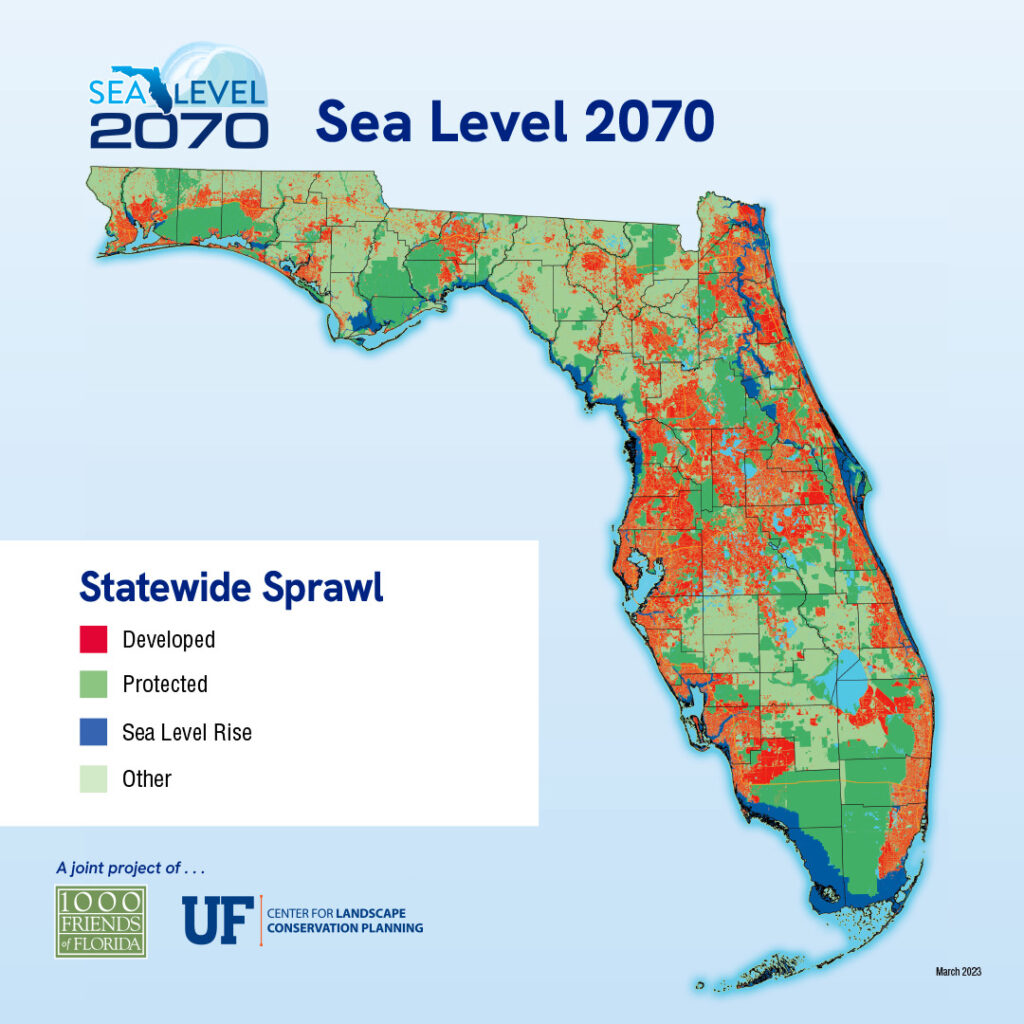By Vivian Young, 1000 Friends of Florida
Florida is facing a pressing reality. Our state is at risk of “losing” close to 5.2 million of its 36 million acres of land by 2070, according to Sea Level 2070, a GIS-based analysis by the University of Florida Center for Landscape Conservation Planning and 1000 Friends of Florida.

This includes 1.7 million acres lost to sea level rise and 3.5 million acres to sprawling new development. Meanwhile, under moderate projections, Florida’s population is set to grow close to 60% – or by 12.2 million more residents – over the same period.
This means more people will live on increasingly less land.
This is exacerbated by Florida’s sprawling development patterns, which accommodate fewer people on each acre of land. Sprawling development eats into our natural and agricultural lands faster than compact development. This threatens our rural lands, which provide essential ecosystem services such as cleansing and storing our drinking water, supporting flood control, harboring wildlife and sequestering carbon. Additionally, agriculture is a cornerstone of Florida’s economy, providing essential food security.
Sprawling development threatens Florida’s future environmental sustainability and fiscal sustainability.
Urban3 compares the revenue generated per acre of development with what a community’s taxpayers pay for roads, water and sewer lines, and other infrastructure needed to support the development. In its just-released report, “The Economics of Development in Florida,” Urban3 concludes that low-density development does not produce enough tax revenue per acre to pay for its infrastructure liabilities, making it fiscally insolvent over the long term.
By contrast, denser, walkable, mixed-use development patterns produce far more tax revenue per acre than is needed for their associated infrastructure. And while rural lands do not generate as much property tax, they demand far less in services.
Simply put, less infrastructure is less expensive. After all, cows don’t go to school.
What can we do to create a more sustainable and hopeful future?
- Do the math on development: Measure development fiscal productivity in new and old development patterns to better understand the fiscal consequences of growth and how to best maintain the long-term fiscal health of your community.

- Invest in urban areas: Cities have a stronger economic position if their average value per acre in their downtown core is six times as high as the city average. Proper infill development, mixed uses and walkable urbanism, which refers to the design of urban areas that encourages walking and public transit, support this.
- Increase fiscal productivity in suburban areas: Existing suburban areas can be retrofitted with areas of higher productivity through infill development, new mixed-use centers and enhanced walkability to help compensate for the inherent subsidy in the low-density pattern.
- Keep rural lands rural: Rural lands generate less property and sales tax revenue than urbanized areas while demanding only minimal infrastructure. Planning and land conservation strategies can help protect natural and agricultural lands to promote environmental and fiscal sustainability.
Our local governments hold the key to a more sustainable future. By understanding and making decisions based on the short- and long-term fiscal consequences of development, they can play a pivotal role in promoting sustainability while saving taxpayer dollars.
Vivian Young, AICP, is special projects director for 1000 Friends of Florida, which partners with citizens to promote a more environmentally and fiscally sustainable Florida. Urban3 prepared “The Economics of Development in Florida” for 1000 Friends of Florida, the University of Florida Center for Landscape Conservation Planning and Live Wildly. It is available at 1000fof.org/priorities/fiscal. Sea Level 2070, prepared by the Center and 1000 Friends in 2023, is available at 1000fof.org/sealevel2040.
Sign up for The Invading Sea newsletter by visiting here. To support The Invading Sea, click here to make a donation. If you are interested in submitting an opinion piece to The Invading Sea, email Editor Nathan Crabbe at ncrabbe@fau.edu. Banner photo: An aerial view of Daytona Beach (iStock image).



